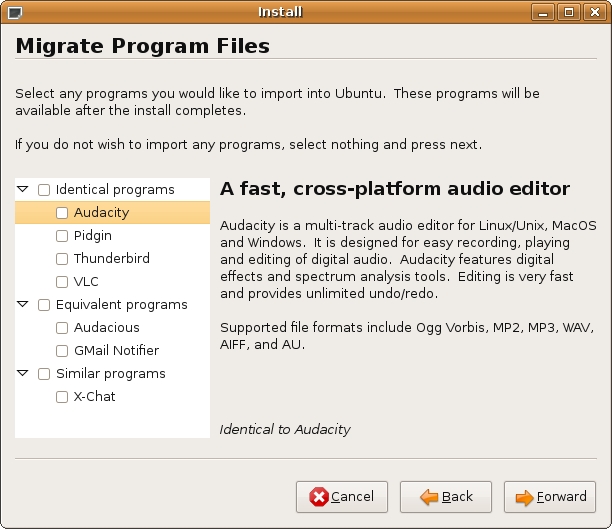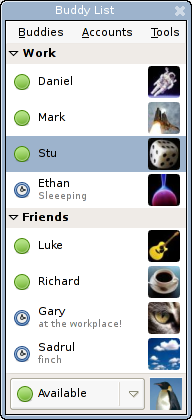Monday, June 29, 2009
Administrative: Moving
I'm moving at the end of August. I'm not just moving, though, I'm selling almost all my stuff and going to another country. The period before and after the move will be busy and stressful. Expect very few articles in the next two months.
Once in my new home, I'll have two months off and will have a ton of time to write. I'll try to make up for the dry spell then.
Tuesday, June 23, 2009
Move Over Opera Unite: Welcome Meiga
Opera Unite allows you to easily share your data: photos, music, notes and other files. You can even run chat rooms and host entire Web sites with Opera Unite. It puts the power of a Web server in your browser, giving you greater privacy and flexibility than other online services.[1]
In case you don't want to run a pre-release version of Opera, you can get similar results with Meiga. It's written in a combination of Vala and C. According to the website:
The current trend in the Internet is to publish contents in centralized servers to be shared to other people. Nevertheless, sometimes it's handy for users to be able to serve their own contents directly from their desktops in a convenient way (instead of using a pendrive, for instance). Why bothering about publishing y
our contents if you can share them directly from your desktop to the LAN or even to the whole Internet?
It can punch holes through uPnp-aware routers to make the operation automatic. Meiga can even publish an RSS feed of your shared items. The program's lighter than gnome-user-share since Meiga doesn't use Apache. Since Meiga uses Gnome technologies, it fits right into the standard Ubuntu desktop. Packages are available for Hardy, Intrepid, and Jaunty.To satisfy this need we've created Meiga, a tool that makes possible to share selected local directories via web. But that's only the beginning. In fact, the ultimate goal of the project is to serve as a common publishing point for other desktop applications, such as the file manager, picture viewers or music players.

Sunday, June 21, 2009
Migration Assistant to Automatically Install Equivalent Programs
The Migration Assistant should offer to install (equivalents of) known programs during the installation process. The program should recognise three levels of equivalence: identical (same codebase), equivalent (different codebase, but one is specifically modeled on the other), and similar(unrelated program that does the same job). The assistant should recognise at least the following packages:
Wednesday, June 17, 2009
Empathy and Banshee to be in Karmic (9.10)?
Empathy has a much better chance this time. I give it an 80% shot for the following reasons:
- Empathy is Gnome's default IM client. Tighter integration is better.
- Empathy is pretty close to Pidgin with regard to fatures.
- Empathy is a better path forward, and is starting to include features which Pidgin doesn't have, like video chat or sharing your desktop with any Empathy contact.
- Empathy is extremely active, topping the Gnome weekly commit list for the last four weeks and having over 600 commits during that period, well above other projects.
- It's guaranteed to be in either Karmic or Karmic +1, and putting it in now will allow it to mature and be debugged for the LTS.
On a similar note, the Ubuntu Developer Summit (UDS) debated replacing Rhythmbox (RB) with Banshee. This decision was probably originally driven by the RB dev's desire to stop developing the project, but that later turned out to be a tempest in a teacup, as the dev started up again and Google Summer of Code (SoC) has a couple of RB projects to add missing functions like sync'ing.
Banshee was seen as a better long-term solution during the debate, but the music player lacked some of the functionality of Rhythmbox. What are the blockers and other major problems for Banshee?
- It didn't have a dynamically loaded music library without the use of plug-ins;
- There are accessibility (a11y) problems with Mono, and Banshee inherits those;
- Online stores like Jamendo and Magnatune aren't supported;
- Migration from RB for current users needs to be tested well;
- There is, of course, the Mono debate, but Tomboy is included by default, so I doubt the argument will go much of anywhere.
My odds on Banshee making it? 1:2. That's a 67% chance, there, by my reckoning. My reasons? I think the blockers can get handled in time and, just like Empathy, everyone wants Banshee in Karmic +1.
Tuesday, June 16, 2009
Why One Hundred Paper Cuts is Great but Will Ultimately Fail
 Image via Wikipedia
Image via WikipediaThere's hope on the horizon, though. One Hundred Paper Cuts is "A project led by Canonical's Design and User Experience team to improve user experience in Ubuntu by identifying 100 small points of pain for users, or "paper cuts", and healing them!" Unfortunately, many more bugs have been reported than the required 100, and these bugs need to be triaged. Users are encouraged to look for bugs that don't meet the criteria:
- bugs that are system-wide (Nautilus, Gnome panel, etc), rather than app-specific (F-Spot, OOo, Terminal, etc.)
- bugs that impact standard workflows (like connecting to the network, copying files, browsing folders, etc.), rather than specialised or corner case workflows
- bugs that are easy to address, rather that ones that require significant design or development efforts
- issues with existing features, rather than requests for new features
- bugs that relate to usability and design (like size of the notification bubbles), rather than broken software (e.g. notifications flickering in fullscreen)
My prediction? 100PC will ultimately fail because of:
- Politics over which bugs are "important"
- Real problems on the desktop that could be targetted will be marked "Invalid" because they don't affect Nautilus or Gnome Panel (or even if they do).
Sunday, June 14, 2009
GYache Improved: a Full-Featured Yahoo! IM Client

Pidgin is a cool IM client, but a lot of people (especially ex-Windows IMers) want more than the minimal features offered by a multi-protocol IM client. Most people know about aMSN as an MSN replacements, but few know about GYache Improved, the Yahoo! IM client with packages for most major distributions. GYache Improved is a fork of GYache Enhanced, and sports the following "advanced" features:
- voice chat,
- webcams,
- faders,
- 'nicknames',
- audibles,
- avatars, and
- display images

You can get GI packages from the download page (here's a direct link to the Launchpad PPA for Ubuntu users).

eBox Moves Onto the Desktop
- Authentication against eBox LDAP: The user database is stored only on the eBox server and if you have an account on it you can login from any machine on the network. This works exactly as the PDC feature for Windows clients, but in this case with Ubuntu clients.
- Autoconfiguration of desktop clients for the services provided by eBox (mail, samba, Jabber, VoIP, ...): The first time the user logs in a machine it creates a home directory with the proper preconfigured settings.
- Evolution (Mail service): The mail account of the user is read from ldap and added.
- Nautilus (File sharing): Links to the samba user share and all group shares for the user are added on the desktop.
- Ekiga (VoIP): The asterisk account for the user is added. A workaround is needed to ask the user for the password before start Ekiga the first time because it can't do it if it isn't specified in the configuration.
- Pidgin (Jabber service): The jabber account of the user (if it has one) is added. It also adds a conference to its buddy list for each group that the user belongs to.
- Firefox (eGroupware & User corner): Links to this two services are added to the bookmarks toolbar. Currently it only works if the user corner port is the default one (8888).
Wow. This is the first dead-simple log-on service for Ubuntu clients (that I know of, anyway, and I try to keep my ear to the ground). SUSE and RHEL have had good solutions for their distributions for a while, but eBox sets Ubuntu 9.04 and beyond up for SME use.
Friday, June 12, 2009
Ubuntu 9.10 is getting an installation slideshow
The slideshow is written in HTML and CSS, and uses a main page to embed the other ones. The README file for the code indicates that slides should be 700x420 in order to fit on displays of 800x600. Since the PlaySlideshow.sh file only contains "xdg-open URL," I can assume the slideshow will appear in the default browser for the system being installed.
I've done a video of the slideshow for you to watch: remember that it's a draft and Dylan is asking for assistance on this.
Thursday, June 4, 2009
What is eBox and Why Should You Care?
- a set of packages to create a robust set of file, mail, DNS, IM, primary domain controller (PDC), LDAP, VPN, and firewall servers on top of an existing Ubuntu installation; or
- a stand-alone distribution CD to do the same.
eBox prides itself in its simplicity and the automation of common enterprise system administrative tasks. It differs from a similar project, Webmin -- probably the most popular administration UI in Linux -- in that eBox hides many of the dirty details and creates a system with reasonable defaults. We can get an idea of the philosophical difference by looking at screenshots of the two projects.
You can see the fundamental difference between the two. Experienced admins will either prefer Webmin or just use SSH, but eBox offers a safe way for former Windows admins to adjust to a Unix/Linux world.
Networking is object oriented, and this allows eBox to work well as a firewall with traffic shaping or caching proxy (even transparent). It can handle DHCP requests or operate as a local DNS (cache or full) or NTP (time) server. Teh VPN functionality lets "road warriors" have access to the business intranet while away from the office, and can even connect two offices permanently so they appear to be on the same network.
By default, eBox uses LDAP to store user information, meaning that it is probably the easiest way to get an LDAP server up and running. There are numerous horror stories and multi-page howtos for the would-be OpenLDAP users. All the services are tied into LDAP, so you can run a Windows PDC and an LDAP server side by side without having to sync users. DHCP even supports booting diskless thin clients.
Printers are handled using the CUPS printing server, but eBox uses its own integrated configuration UI instead of CUPS'. Printers are shared equally well to Windows, Linux, or OS X machines.
File sharing uses Samba, unsurprisingly. Simple file serving is offered as well as PDC capability. Quotas and roaming profiles are available with the check of a box. In addition to user shares, group shares for teams are also available.
Not only is mail handled, with POP3 and IMAP, but it is possible to use virtual domains for the mail and mail aliases are supported. If your business uses internal IM in addition to mail, the Jabber server is simple to set up.
Think all this functionality is too much for a single server? You're right. eBox knows this and offers a SOAP interface so that multiple boxes -- even geographically diverse ones -- can be controlled from a single interface.
Certified courses for administrators have begun to pop up, and the future looks bright for such a young project. Version 1.2 promises more options like PBX (Asterisk), filters for the web proxy, IM proxies, and intrusion decetion system (IDS) integration via Snort.
Download the eBox live CD and take a look. Installation disks and packages are also available.

![Reblog this post [with Zemanta]](http://img.zemanta.com/reblog_e.png?x-id=e1d978f5-c87c-4f5d-a252-330eb0e13347)

![Reblog this post [with Zemanta]](http://img.zemanta.com/reblog_e.png?x-id=bcdcf081-315c-4c0f-aa34-eb141c3572fc)

![Reblog this post [with Zemanta]](http://img.zemanta.com/reblog_e.png?x-id=d9277c8b-ac91-472a-a568-b3236a9f6290)


![Reblog this post [with Zemanta]](http://img.zemanta.com/reblog_e.png?x-id=59c8034c-0085-4de7-a8cb-f1b309f2744f)
![Reblog this post [with Zemanta]](http://img.zemanta.com/reblog_e.png?x-id=96ba58e2-47ec-45ed-a19f-e354ebfd9a03)
![Reblog this post [with Zemanta]](http://img.zemanta.com/reblog_e.png?x-id=a8eeb600-6fb7-4052-b7cf-4abd5d3208b6)



![Reblog this post [with Zemanta]](http://img.zemanta.com/reblog_e.png?x-id=127ae0f1-eb96-4522-915c-fa0d614ae7d8)